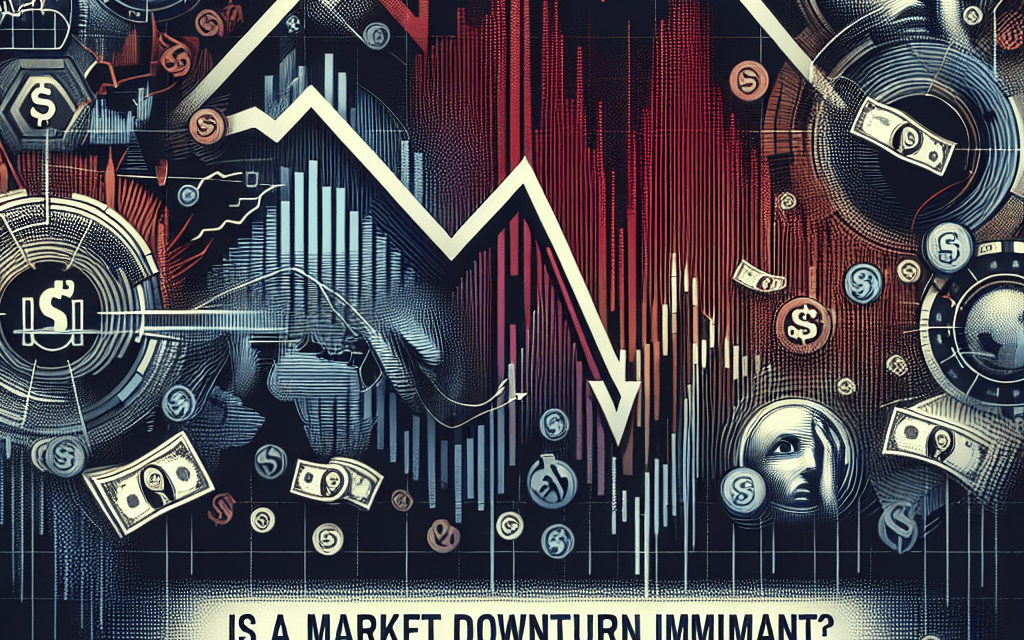“Brace for Impact: A Trusted Tool Signals a Market Downturn Ahead”
Introduction
In the ever-fluctuating world of finance, predicting market trends is both an art and a science, with investors constantly seeking reliable indicators to guide their decisions. As economic uncertainties loom large, the question on everyone’s mind is whether a market downturn is imminent. Recent analyses using a well-regarded forecasting tool suggest that such a downturn might be on the horizon. This tool, known for its historical accuracy in identifying market shifts, has begun to signal potential vulnerabilities in the current economic landscape. By examining key economic indicators, investor sentiment, and historical patterns, this forecasting method provides a comprehensive outlook that could help investors brace for potential market turbulence. As we delve into the intricacies of this forecast, it becomes crucial to understand the factors at play and the implications for both short-term and long-term investment strategies.
Understanding Market Downturns: Key Indicators to Watch
In the ever-evolving landscape of financial markets, predicting a downturn is a task fraught with complexity and uncertainty. However, understanding key indicators can provide valuable insights into potential market shifts. One such reliable forecasting tool that has garnered attention is the yield curve, particularly the relationship between short-term and long-term interest rates. Historically, an inverted yield curve, where short-term rates exceed long-term rates, has been a precursor to economic recessions and market downturns. This phenomenon occurs because investors anticipate a slowdown in economic growth, prompting them to seek the safety of long-term bonds, thereby driving down their yields.
Moreover, the yield curve is not the only indicator to consider. Market analysts often examine a range of economic data to gauge the health of the financial environment. For instance, the unemployment rate is a critical metric. A sudden increase in unemployment can signal weakening economic conditions, as it often leads to reduced consumer spending, which in turn affects corporate earnings and stock prices. Additionally, consumer confidence indices provide insights into the public’s economic outlook. A decline in consumer confidence can foreshadow reduced spending and investment, further exacerbating market vulnerabilities.
Transitioning to corporate performance, earnings reports are another vital indicator. Companies that consistently miss earnings expectations may reflect broader economic challenges. When a significant number of firms report disappointing earnings, it can lead to a loss of investor confidence, triggering sell-offs and contributing to a market downturn. Furthermore, the price-to-earnings (P/E) ratio is a widely used metric to assess whether stocks are overvalued or undervalued. Elevated P/E ratios may suggest that stocks are overpriced, increasing the risk of a market correction.
In addition to these economic and corporate indicators, geopolitical events can also play a significant role in influencing market conditions. Political instability, trade tensions, and international conflicts can create uncertainty, leading to increased market volatility. Investors often react to such events by reallocating their portfolios, which can result in abrupt market movements. Therefore, staying informed about global developments is crucial for anticipating potential market downturns.
While these indicators provide valuable insights, it is essential to recognize that no single metric can predict market movements with absolute certainty. Instead, a comprehensive analysis that considers multiple factors is necessary for a more accurate forecast. Moreover, it is important to acknowledge that markets are inherently cyclical, and downturns, while challenging, are a natural part of the economic cycle. They often serve as a reset mechanism, allowing for the correction of imbalances and paving the way for future growth.
In conclusion, while a market downturn may seem imminent based on certain indicators, it is crucial to approach such predictions with caution. By closely monitoring the yield curve, unemployment rates, consumer confidence, corporate earnings, and geopolitical events, investors can better understand the potential risks and opportunities that lie ahead. Ultimately, maintaining a diversified portfolio and adopting a long-term investment strategy can help mitigate the impact of market volatility, ensuring resilience in the face of economic uncertainties.
The Role of Forecasting Tools in Predicting Economic Trends
In the ever-evolving landscape of global economics, the ability to predict market trends is a highly sought-after skill. Investors, policymakers, and financial analysts alike rely on a variety of forecasting tools to anticipate economic shifts and make informed decisions. Among these tools, some have gained prominence for their reliability and accuracy in predicting market downturns. As the global economy faces increasing uncertainty, the question arises: is a market downturn imminent? A reliable forecasting tool suggests it might be.
Forecasting tools are essential in the realm of economic analysis, as they provide valuable insights into potential future market conditions. These tools utilize a combination of historical data, statistical models, and economic indicators to generate predictions about the direction of the market. One such tool, which has garnered attention for its predictive capabilities, is the yield curve. The yield curve, a graphical representation of interest rates across different maturities, has historically been a strong indicator of economic health. An inverted yield curve, where short-term interest rates exceed long-term rates, has often preceded economic recessions.
In recent months, the yield curve has shown signs of inversion, raising concerns among economists and investors. This inversion suggests that investors are seeking long-term security, possibly due to expectations of an economic slowdown. While the yield curve is not infallible, its track record in predicting recessions cannot be ignored. Moreover, it is important to consider other economic indicators that may corroborate the yield curve’s warning. For instance, declining consumer confidence, slowing industrial production, and weakening global trade are all factors that could contribute to an impending market downturn.
Transitioning from the yield curve, another forecasting tool that merits attention is the Purchasing Managers’ Index (PMI). The PMI is a measure of the prevailing direction of economic trends in the manufacturing and service sectors. A PMI reading below 50 indicates contraction, while a reading above 50 suggests expansion. Recent PMI data has shown a downward trend, signaling potential economic contraction. This decline in PMI, coupled with the yield curve inversion, paints a concerning picture of the economic landscape.
Furthermore, geopolitical tensions and policy uncertainties add another layer of complexity to economic forecasting. Trade disputes, political instability, and regulatory changes can all have significant impacts on market dynamics. These factors, while difficult to quantify, must be considered when evaluating the likelihood of a market downturn. The interplay between these elements and traditional economic indicators can provide a more comprehensive understanding of potential future trends.
In conclusion, while no forecasting tool can predict the future with absolute certainty, the convergence of multiple indicators suggests that a market downturn may be on the horizon. The yield curve inversion, declining PMI, and geopolitical uncertainties all point towards a potential economic slowdown. As such, it is crucial for investors and policymakers to remain vigilant and consider these signals when making strategic decisions. By leveraging reliable forecasting tools and staying informed about global economic developments, stakeholders can better navigate the complexities of the market and mitigate potential risks.
Historical Analysis: How Accurate Are Market Forecasting Tools?
Market forecasting tools have long been a subject of interest and debate among investors, economists, and financial analysts. These tools, which range from complex algorithms to more traditional economic indicators, aim to predict future market movements and provide valuable insights for decision-making. However, the accuracy of these tools has often been questioned, as the financial markets are influenced by a myriad of factors, both predictable and unforeseen. In this context, understanding the historical accuracy of market forecasting tools becomes crucial, especially when a reliable tool suggests that a market downturn might be imminent.
Historically, market forecasting tools have had varying degrees of success. Some tools, like the yield curve inversion, have been relatively reliable indicators of economic downturns. The yield curve, which plots the interest rates of bonds with equal credit quality but differing maturity dates, has inverted before each of the last several U.S. recessions. This inversion occurs when short-term interest rates exceed long-term rates, signaling investor pessimism about the near-term economy. Despite its historical accuracy, the yield curve is not infallible and can sometimes produce false positives, as seen in certain periods where an inversion did not lead to a recession.
Another widely used tool is the stock market’s price-to-earnings (P/E) ratio, which measures a company’s current share price relative to its per-share earnings. Historically, a high P/E ratio has often been interpreted as a sign that stocks are overvalued and that a market correction may be on the horizon. However, the P/E ratio must be considered in the context of broader economic conditions, as high valuations can persist for extended periods without an immediate downturn.
In addition to these traditional indicators, modern forecasting tools have increasingly incorporated advanced technologies such as machine learning and artificial intelligence. These tools analyze vast amounts of data, identifying patterns and trends that may not be immediately apparent to human analysts. While these technologies hold great promise, their predictive accuracy is still being evaluated, as they are relatively new compared to more established methods.
Despite the inherent uncertainties in market forecasting, some tools have demonstrated a remarkable ability to predict downturns with a reasonable degree of accuracy. For instance, the Conference Board’s Leading Economic Index (LEI) is a composite of ten economic indicators that has historically provided early signals of turning points in the business cycle. The LEI has successfully predicted several past recessions, although, like all tools, it is not immune to errors.
As we consider the possibility of an imminent market downturn, it is essential to recognize that no single tool can provide absolute certainty. Instead, a combination of indicators, both traditional and modern, should be used to form a comprehensive view of the market’s future trajectory. By analyzing these tools in conjunction with one another, investors and analysts can better assess the likelihood of a downturn and make more informed decisions.
In conclusion, while market forecasting tools have varying degrees of historical accuracy, they remain invaluable in providing insights into potential future market movements. As a reliable forecasting tool suggests the possibility of an imminent downturn, it is crucial to approach such predictions with a balanced perspective, considering both the strengths and limitations of these tools. By doing so, stakeholders can navigate the complexities of the financial markets with greater confidence and preparedness.
Investor Strategies: Preparing for a Potential Market Downturn

In the ever-evolving landscape of financial markets, investors are perpetually on the lookout for signs that might indicate an impending downturn. The ability to anticipate market shifts can be the difference between safeguarding one’s investments and suffering significant losses. Recently, a reliable forecasting tool has suggested that a market downturn might be on the horizon, prompting investors to reassess their strategies. This tool, which has historically demonstrated accuracy in predicting market trends, is now signaling caution, urging investors to prepare for potential volatility.
One of the primary indicators that this forecasting tool relies on is the analysis of economic cycles. Economic cycles, characterized by periods of expansion and contraction, have long been a fundamental aspect of market behavior. By examining historical data and current economic indicators, the tool identifies patterns that often precede market downturns. For instance, rising interest rates, inflationary pressures, and geopolitical tensions are among the factors that can contribute to a shift in market sentiment. As these elements converge, the likelihood of a downturn increases, making it imperative for investors to remain vigilant.
In addition to economic cycles, the tool also considers market sentiment and investor behavior. Market sentiment, often driven by psychological factors, can significantly influence market movements. When investors become overly optimistic, markets may become overvalued, setting the stage for a correction. Conversely, when pessimism prevails, markets may undervalue assets, creating opportunities for astute investors. By analyzing sentiment indicators such as the volatility index (VIX) and investor surveys, the forecasting tool provides insights into the prevailing mood of the market, offering valuable guidance for investors.
Given the potential for a market downturn, investors are advised to adopt strategies that can mitigate risk and preserve capital. Diversification remains a cornerstone of prudent investing, as it reduces exposure to any single asset class or sector. By spreading investments across a range of assets, including stocks, bonds, and commodities, investors can cushion the impact of a market decline. Furthermore, maintaining a balanced portfolio that aligns with one’s risk tolerance and investment goals is essential in navigating uncertain times.
Another strategy that investors might consider is the use of hedging techniques. Hedging involves taking positions in financial instruments that offset potential losses in other investments. Options and futures contracts are commonly used for this purpose, providing a form of insurance against adverse market movements. While hedging can be complex and may involve additional costs, it offers a layer of protection that can be invaluable during periods of heightened volatility.
Moreover, investors should remain informed and adaptable, as market conditions can change rapidly. Staying abreast of economic developments, corporate earnings reports, and geopolitical events can provide critical insights that inform investment decisions. Additionally, maintaining a long-term perspective can help investors avoid making impulsive decisions based on short-term market fluctuations. By focusing on fundamental analysis and the intrinsic value of investments, investors can better withstand the pressures of a downturn.
In conclusion, while the prospect of a market downturn may be unsettling, it also presents an opportunity for investors to reassess their strategies and fortify their portfolios. By leveraging reliable forecasting tools and adopting prudent investment practices, investors can navigate the challenges of a volatile market environment. As history has shown, markets are cyclical, and with careful planning and foresight, investors can position themselves to weather the storm and emerge stronger on the other side.
The Impact of Market Downturns on Global Economies
Market downturns have long been a subject of concern for economists, investors, and policymakers alike, given their profound impact on global economies. These downturns, characterized by a significant decline in market prices, can lead to widespread economic repercussions, affecting everything from employment rates to international trade. As such, the ability to forecast these downturns with accuracy is of paramount importance. Recently, a reliable forecasting tool has suggested that a market downturn might be imminent, raising questions about the potential impact on global economies.
To understand the implications of a market downturn, it is essential to consider the interconnected nature of modern economies. In today’s globalized world, financial markets are intricately linked, meaning that a downturn in one region can quickly ripple across borders. For instance, a significant decline in the stock market of a major economy like the United States or China can lead to reduced consumer confidence and spending, not only domestically but also in countries that rely on these markets for trade. Consequently, businesses may face decreased demand for their products, leading to lower revenues and potential layoffs, which further exacerbate the economic slowdown.
Moreover, market downturns can have a profound impact on investment flows. During periods of economic uncertainty, investors often seek to minimize risk by pulling out of volatile markets and reallocating their capital to safer assets, such as government bonds or gold. This shift in investment behavior can lead to a decrease in capital available for businesses, particularly in emerging markets that rely heavily on foreign investment. As a result, these economies may experience slower growth or even contraction, as they struggle to finance development projects and maintain economic stability.
In addition to affecting trade and investment, market downturns can also influence monetary policy. Central banks around the world often respond to economic slowdowns by adjusting interest rates in an attempt to stimulate growth. Lowering interest rates can encourage borrowing and spending, as it reduces the cost of loans for consumers and businesses. However, this approach is not without its challenges. Persistently low interest rates can lead to inflationary pressures and may limit the central bank’s ability to respond to future economic crises. Furthermore, in a global context, divergent monetary policies can lead to currency fluctuations, impacting international trade and investment.
The social implications of market downturns should not be overlooked either. Economic slowdowns often lead to increased unemployment rates, as businesses cut costs to weather the storm. This can result in a rise in poverty levels and income inequality, as those who lose their jobs may struggle to find new employment opportunities. Additionally, governments may face increased pressure to provide social safety nets and support for affected individuals, straining public finances and potentially leading to higher taxes or reduced public services.
In conclusion, the potential for an imminent market downturn, as suggested by a reliable forecasting tool, underscores the need for vigilance and preparedness among global economies. The interconnected nature of today’s financial markets means that the impact of such a downturn would likely be widespread, affecting trade, investment, monetary policy, and social stability. As policymakers and investors brace for the possibility of economic turbulence, understanding the multifaceted effects of market downturns is crucial for mitigating their impact and ensuring a resilient global economy.
Psychological Factors: How Fear and Greed Influence Market Trends
In the complex world of financial markets, the interplay of psychological factors such as fear and greed often plays a pivotal role in shaping market trends. These emotions, deeply rooted in human nature, can significantly influence investor behavior, leading to market fluctuations that may not always align with fundamental economic indicators. As investors grapple with the uncertainty of market movements, understanding the psychological underpinnings of fear and greed becomes crucial in anticipating potential downturns.
Fear, a powerful emotion, can lead to panic selling, causing markets to plummet. When investors perceive a threat to their financial well-being, whether due to geopolitical tensions, economic instability, or unexpected corporate earnings reports, they may react impulsively. This reaction is often exacerbated by the herd mentality, where individuals follow the actions of others, assuming that the collective wisdom of the crowd is correct. Consequently, fear-driven sell-offs can create a self-fulfilling prophecy, where declining prices lead to further panic and more selling, thus amplifying the downturn.
Conversely, greed can drive markets to unsustainable heights. During periods of economic optimism, investors may become overly confident, driven by the desire for higher returns. This can lead to speculative bubbles, where asset prices are inflated beyond their intrinsic value. The dot-com bubble of the late 1990s and the housing bubble of the mid-2000s serve as stark reminders of how unchecked greed can lead to market excesses. When the bubble eventually bursts, the resulting correction can be swift and severe, leaving investors grappling with significant losses.
The cyclical nature of fear and greed suggests that these emotions are not isolated phenomena but rather interconnected forces that can drive market cycles. As one emotion wanes, the other often gains strength, creating a dynamic interplay that can lead to market volatility. Recognizing this pattern, some investors and analysts have turned to sentiment analysis as a forecasting tool. By gauging the prevailing mood of the market, they aim to predict potential turning points and adjust their strategies accordingly.
Sentiment analysis, which involves assessing the emotional tone of news articles, social media posts, and other public communications, provides valuable insights into the collective mindset of investors. When sentiment indicators point to extreme levels of fear or greed, it may signal that a market reversal is imminent. For instance, a surge in pessimistic sentiment could suggest that a market bottom is near, as fear reaches its peak and selling pressure subsides. Conversely, excessive optimism might indicate that a market top is approaching, as greed drives prices to unsustainable levels.
While sentiment analysis is not foolproof, it offers a complementary perspective to traditional financial analysis. By incorporating psychological factors into their decision-making process, investors can gain a more holistic understanding of market dynamics. This approach can help them navigate the complexities of market cycles, potentially mitigating the impact of downturns and capitalizing on opportunities during upswings.
In conclusion, the influence of fear and greed on market trends underscores the importance of considering psychological factors in financial analysis. As these emotions continue to shape investor behavior, tools like sentiment analysis provide valuable insights into potential market movements. By understanding and anticipating the impact of fear and greed, investors can better position themselves to weather market downturns and seize opportunities for growth.
Case Studies: Successful Predictions of Past Market Downturns
In the realm of financial markets, predicting downturns is a task fraught with complexity and uncertainty. However, certain forecasting tools have demonstrated a remarkable ability to anticipate these downturns with a degree of accuracy that commands attention. One such tool, which has gained recognition for its predictive prowess, is the yield curve inversion. Historically, this tool has been a reliable harbinger of economic recessions and subsequent market downturns, offering investors a glimpse into the future and allowing them to make informed decisions.
To understand the efficacy of the yield curve inversion as a forecasting tool, it is instructive to examine its track record in predicting past market downturns. The yield curve, which plots the interest rates of bonds with equal credit quality but differing maturity dates, typically slopes upward, reflecting higher yields for longer-term investments. However, when short-term interest rates exceed long-term rates, the curve inverts, signaling potential economic trouble ahead. This inversion has preceded every U.S. recession since the 1950s, making it a critical indicator for market analysts.
One notable instance of the yield curve inversion accurately predicting a market downturn occurred in the late 1980s. In December 1988, the yield curve inverted, and by July 1990, the U.S. economy had entered a recession. This downturn was accompanied by a significant decline in stock market values, validating the yield curve’s predictive capability. Similarly, in the early 2000s, the yield curve inverted in 2000, preceding the dot-com bubble burst and the subsequent recession in 2001. Investors who heeded this warning were better positioned to mitigate losses during the market’s decline.
Moreover, the yield curve inversion’s predictive success was evident during the 2007-2008 financial crisis. Inverted in late 2006, the yield curve signaled an impending economic slowdown. By December 2007, the U.S. was officially in a recession, and the stock market experienced one of its most severe downturns in history. The yield curve’s ability to forecast this crisis underscored its value as a tool for anticipating market movements.
While the yield curve inversion is not infallible, its historical accuracy in predicting recessions and market downturns is noteworthy. It is important to recognize that the yield curve is not a standalone predictor; rather, it should be considered alongside other economic indicators and market conditions. Nevertheless, its consistent track record provides a compelling case for its inclusion in any comprehensive market analysis.
In recent times, the yield curve has once again garnered attention as it has shown signs of inversion. This development has sparked discussions among economists and investors about the possibility of an impending market downturn. While no forecasting tool can guarantee certainty, the yield curve’s historical performance suggests that it is prudent to consider its implications seriously.
In conclusion, the yield curve inversion stands out as a reliable forecasting tool for predicting market downturns. Its successful predictions in past economic cycles highlight its value to investors seeking to navigate the complexities of financial markets. As we observe current market conditions, the lessons from history remind us of the importance of vigilance and preparedness in the face of potential economic challenges.
Q&A
1. **What is the current state of the market?**
The market is experiencing volatility with signs of potential downturns.
2. **What forecasting tool is being referenced?**
The article refers to a reliable forecasting tool, possibly an economic indicator or model, that suggests a downturn might be imminent.
3. **What are the key indicators of a market downturn?**
Key indicators may include declining stock prices, reduced consumer spending, rising unemployment rates, and negative economic growth forecasts.
4. **How reliable is the forecasting tool mentioned?**
The tool is described as reliable, likely due to its historical accuracy in predicting market trends.
5. **What are the potential impacts of a market downturn?**
Potential impacts include decreased investment returns, increased unemployment, reduced consumer confidence, and potential recession.
6. **What strategies can investors use to prepare for a downturn?**
Investors might consider diversifying their portfolios, increasing cash reserves, and focusing on defensive stocks or sectors.
7. **What is the general sentiment among economists regarding the forecast?**
Economists may have mixed opinions, with some agreeing with the forecast while others remain optimistic about market resilience.
Conclusion
The conclusion about whether a market downturn is imminent, based on a reliable forecasting tool, suggests that there are indicators pointing towards a potential decline. While no forecasting tool can predict market movements with absolute certainty, the presence of certain economic signals, such as declining consumer confidence, rising interest rates, or geopolitical tensions, may increase the likelihood of a downturn. Investors should remain cautious and consider diversifying their portfolios to mitigate potential risks. However, it’s important to continuously monitor the market and economic conditions, as they can change rapidly and affect the accuracy of any forecast.





